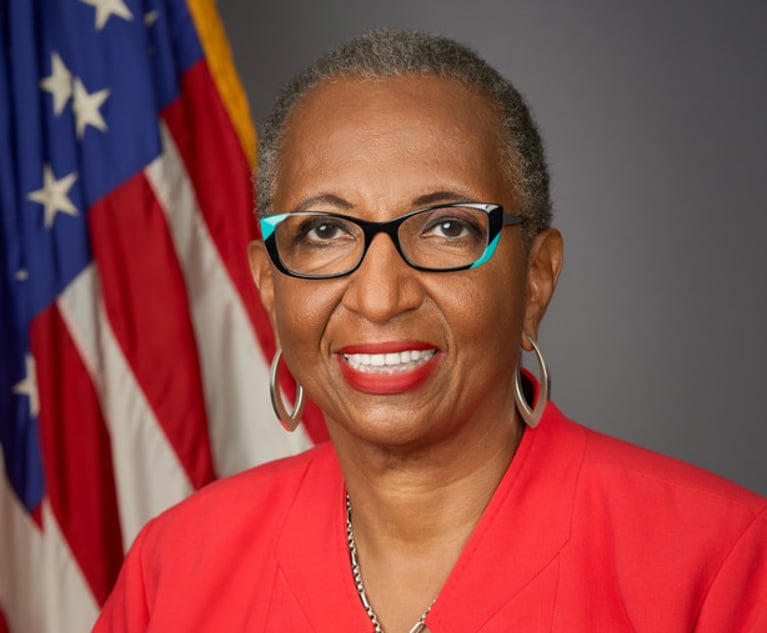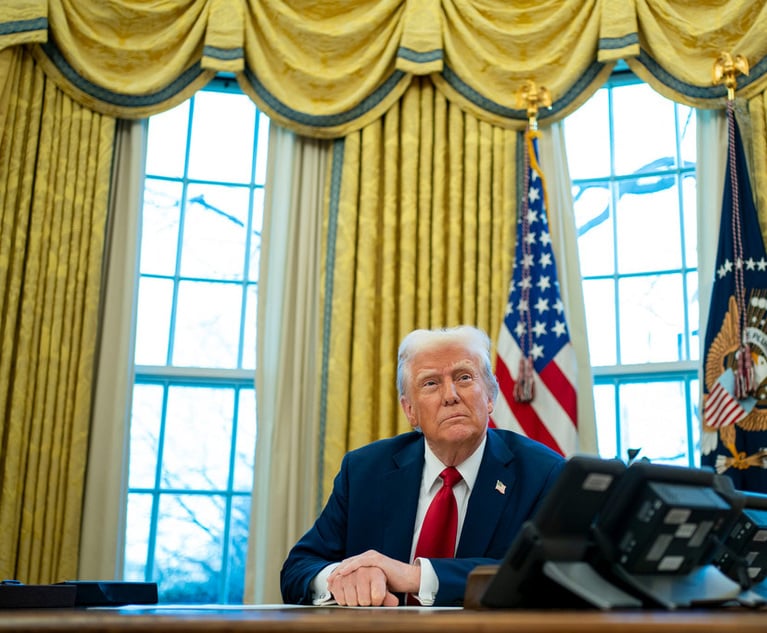Regulatory: The Department of the Interior releases its final land-based wind energy guidelines
On March 23, the United States Fish and Wildlife Service (FWS) issued its Final Voluntary Land-Based Wind Energy Guidelines.
April 18, 2012 at 07:21 AM
6 minute read
The original version of this story was published on Law.com
On March 23, the United States Fish and Wildlife Service (FWS) issued its Final Voluntary Land-Based Wind Energy Guidelines. The purpose of the guidelines is to provide a structured, scientific process for the evaluation and mitigation of impacts of wind energy projects on wildlife conservation at all stages of land-based wind energy development, as well as to promote more effective communication among wind energy developers and conservation agencies at all levels of government. The guidelines' definition of “project” is broad, including “all phases of wind energy development, including, but not limited to, prospecting, site assessment, construction, operation and decommissioning, as well as all associated infrastructure and interconnecting electrical lines.”
The final guidelines have long been awaited as a necessary response to increasing wind energy development in the U.S. The FWS originally released interim guidelines in July 2003. In an effort to address the diverse concerns of a myriad of stakeholders, the Department of the Interior established a Federal Advisory Committee to provide recommendations to revise the interim guidelines with respect to land-based wind energy facilities. In March 2007, the Department of the Interior established the Wind Turbine Guidelines Advisory Committee which submitted its final recommended guidelines to the Secretary of the Interior on March 4, 2010.
This final version of the guidelines uses a tiered approach for assessing potential adverse impacts on species of concern and their habitat. During preconstruction tiers (Tiers 1-3, ranging from landscape scale screening of possible project sites through field studies to document site wildlife and habitat and forecast potential impacts), developers are working to identify, avoid or minimize risks to species of concern. During post-construction tiers (Tiers 4 and 5, including post-construction studies to estimate impacts), developers are deciding whether actions taken in earlier tiers to avoid or minimize impacts are achieving their stated goals.
Depending on the availability of necessary data at a particular step, the potential outcomes of the tiered based analysis include:
- The project proceeds to the next tier in the development process without additional data collection
- The project proceeds with additional data collection
- The project requires modification, mitigation or post-construction monitoring
- The project site is abandoned because the risk is unacceptable even with modifications or mitigation.
Finally, while the guidelines are facially voluntary, providing a carrot of collegial cooperation to potential developers, they also carry a big stick. “The guidelines are not intended nor shall they be construed to limit or preclude the [FWS] from exercising its authority under any law, statute, or regulation, or from conducting enforcement actions against any individual, company or agency.”
Applicable statutory authorities that may be enforced by the FWS include the Migratory Bird Treaty, and implementing regulations; the Bald and Golden Eagle Protection Act and implementing regulations; and the Endangered Species Act and implementing regulations.
Ultimately, although the guidelines leave decisions up to the developer, the FWS retains authority to evaluate whether developer efforts to mitigate impacts are sufficient, determine significance and refer for prosecution any unlawful act that it believes to be reasonably related to lack of incorporation of FWS recommendations or insufficient adherence to the guidelines.
On March 23, the United States Fish and Wildlife Service (FWS) issued its Final Voluntary Land-Based Wind Energy Guidelines. The purpose of the guidelines is to provide a structured, scientific process for the evaluation and mitigation of impacts of wind energy projects on wildlife conservation at all stages of land-based wind energy development, as well as to promote more effective communication among wind energy developers and conservation agencies at all levels of government. The guidelines' definition of “project” is broad, including “all phases of wind energy development, including, but not limited to, prospecting, site assessment, construction, operation and decommissioning, as well as all associated infrastructure and interconnecting electrical lines.”
The final guidelines have long been awaited as a necessary response to increasing wind energy development in the U.S. The FWS originally released interim guidelines in July 2003. In an effort to address the diverse concerns of a myriad of stakeholders, the Department of the Interior established a Federal Advisory Committee to provide recommendations to revise the interim guidelines with respect to land-based wind energy facilities. In March 2007, the Department of the Interior established the Wind Turbine Guidelines Advisory Committee which submitted its final recommended guidelines to the Secretary of the Interior on March 4, 2010.
This final version of the guidelines uses a tiered approach for assessing potential adverse impacts on species of concern and their habitat. During preconstruction tiers (Tiers 1-3, ranging from landscape scale screening of possible project sites through field studies to document site wildlife and habitat and forecast potential impacts), developers are working to identify, avoid or minimize risks to species of concern. During post-construction tiers (Tiers 4 and 5, including post-construction studies to estimate impacts), developers are deciding whether actions taken in earlier tiers to avoid or minimize impacts are achieving their stated goals.
Depending on the availability of necessary data at a particular step, the potential outcomes of the tiered based analysis include:
- The project proceeds to the next tier in the development process without additional data collection
- The project proceeds with additional data collection
- The project requires modification, mitigation or post-construction monitoring
- The project site is abandoned because the risk is unacceptable even with modifications or mitigation.
Finally, while the guidelines are facially voluntary, providing a carrot of collegial cooperation to potential developers, they also carry a big stick. “The guidelines are not intended nor shall they be construed to limit or preclude the [FWS] from exercising its authority under any law, statute, or regulation, or from conducting enforcement actions against any individual, company or agency.”
Applicable statutory authorities that may be enforced by the FWS include the Migratory Bird Treaty, and implementing regulations; the Bald and Golden Eagle Protection Act and implementing regulations; and the Endangered Species Act and implementing regulations.
Ultimately, although the guidelines leave decisions up to the developer, the FWS retains authority to evaluate whether developer efforts to mitigate impacts are sufficient, determine significance and refer for prosecution any unlawful act that it believes to be reasonably related to lack of incorporation of FWS recommendations or insufficient adherence to the guidelines.
This content has been archived. It is available through our partners, LexisNexis® and Bloomberg Law.
To view this content, please continue to their sites.
Not a Lexis Subscriber?
Subscribe Now
Not a Bloomberg Law Subscriber?
Subscribe Now
NOT FOR REPRINT
© 2025 ALM Global, LLC, All Rights Reserved. Request academic re-use from www.copyright.com. All other uses, submit a request to [email protected]. For more information visit Asset & Logo Licensing.
You Might Like
View All
Fired NLRB Member Seeks Reinstatement, Challenges President's Removal Power

GOP-Led SEC Tightens Control Over Enforcement Investigations, Lawyers Say

GOP Now Holds FTC Gavel, but Dems Signal They'll Be a Rowdy Minority
6 minute read
Trump's Inspectors General Purge Could Make Policy Changes Easier, Observers Say
Trending Stories
- 1RIP DOJ FCPA Corporate Prosecutions
- 2Federal Trade Commission’s Updates to the Health Breach Notification Rule Now In Effect
- 3I’m A Lawyer, What Can I Sell?
- 4Internal GC Hires Rebounded in '24, but Companies Still Drawn to Outside Candidates
- 5How I Made Office Managing Partner: 'Don’t Be an Opportunity Killer,' Says Thomas Haskins of Barnes & Thornburg
Who Got The Work
J. Brugh Lower of Gibbons has entered an appearance for industrial equipment supplier Devco Corporation in a pending trademark infringement lawsuit. The suit, accusing the defendant of selling knock-off Graco products, was filed Dec. 18 in New Jersey District Court by Rivkin Radler on behalf of Graco Inc. and Graco Minnesota. The case, assigned to U.S. District Judge Zahid N. Quraishi, is 3:24-cv-11294, Graco Inc. et al v. Devco Corporation.
Who Got The Work
Rebecca Maller-Stein and Kent A. Yalowitz of Arnold & Porter Kaye Scholer have entered their appearances for Hanaco Venture Capital and its executives, Lior Prosor and David Frankel, in a pending securities lawsuit. The action, filed on Dec. 24 in New York Southern District Court by Zell, Aron & Co. on behalf of Goldeneye Advisors, accuses the defendants of negligently and fraudulently managing the plaintiff's $1 million investment. The case, assigned to U.S. District Judge Vernon S. Broderick, is 1:24-cv-09918, Goldeneye Advisors, LLC v. Hanaco Venture Capital, Ltd. et al.
Who Got The Work
Attorneys from A&O Shearman has stepped in as defense counsel for Toronto-Dominion Bank and other defendants in a pending securities class action. The suit, filed Dec. 11 in New York Southern District Court by Bleichmar Fonti & Auld, accuses the defendants of concealing the bank's 'pervasive' deficiencies in regards to its compliance with the Bank Secrecy Act and the quality of its anti-money laundering controls. The case, assigned to U.S. District Judge Arun Subramanian, is 1:24-cv-09445, Gonzalez v. The Toronto-Dominion Bank et al.
Who Got The Work
Crown Castle International, a Pennsylvania company providing shared communications infrastructure, has turned to Luke D. Wolf of Gordon Rees Scully Mansukhani to fend off a pending breach-of-contract lawsuit. The court action, filed Nov. 25 in Michigan Eastern District Court by Hooper Hathaway PC on behalf of The Town Residences LLC, accuses Crown Castle of failing to transfer approximately $30,000 in utility payments from T-Mobile in breach of a roof-top lease and assignment agreement. The case, assigned to U.S. District Judge Susan K. Declercq, is 2:24-cv-13131, The Town Residences LLC v. T-Mobile US, Inc. et al.
Who Got The Work
Wilfred P. Coronato and Daniel M. Schwartz of McCarter & English have stepped in as defense counsel to Electrolux Home Products Inc. in a pending product liability lawsuit. The court action, filed Nov. 26 in New York Eastern District Court by Poulos Lopiccolo PC and Nagel Rice LLP on behalf of David Stern, alleges that the defendant's refrigerators’ drawers and shelving repeatedly break and fall apart within months after purchase. The case, assigned to U.S. District Judge Joan M. Azrack, is 2:24-cv-08204, Stern v. Electrolux Home Products, Inc.
Featured Firms
Law Offices of Gary Martin Hays & Associates, P.C.
(470) 294-1674
Law Offices of Mark E. Salomone
(857) 444-6468
Smith & Hassler
(713) 739-1250






